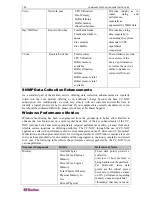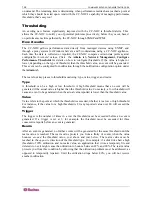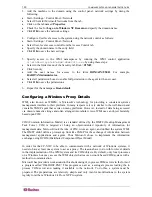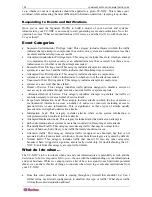
130
COMMANDCENTER NOC ADMINISTRATOR GUIDE
3.
Add the machine to the domain using the control panel, network settings by doing the
following:
•
Start->Settings->Control Panel->Network.
•
Select Client for Microsoft Networks from the tab.
•
Click on the tab named
Properties
.
•
Check the box for
Log on to Windows NT Domain
and specify the domain name.
•
Click
OK
to save the network settings.
4.
Configure User level access to the system using the network control as follows:
•
Start->Settings->Control Panel->Network.
•
Select User-level access control from the Access Control tab.
•
Specify the domain name in the entry field.
•
Click
OK
to save the new settings.
5.
Specify access to the WMI namespaces by running the WMI control application
c:\windows\system\wbem\wbemcntl.exe
by using these steps:
•
Select in the folder menu of the Security tab Root->
CIMv2
.
•
Click Security.
•
Add the user names for access in the form
DOMAIN\USER
. For example,
RARITAN\Administrator
.
•
Select all permission boxes to enable full permission to the agent for the new user.
•
Click
OK
to save the permissions.
6.
Repeat for the namespace
Root-default
.
Configuring a Windows Proxy Details
WMI, also known as WBEM, is Microsoft’s technology for providing a consistent systems
management interface to their platform. In many respects is it very similar to the well-known and
venerable SNMP agent that exists on many platforms. However, instead of data being accessed
via obscure numeric strings and often arranged into tabular views, WMI uses an object hierarchy
based upon CIM.
CIM (Common Information Model) is a standard defined by the DMTF (Desktop Management
Task Force). CIM is targeted at being an object-oriented repository of information for
management data. Microsoft took the idea of CIM, wrote an agent, and dubbed the system WMI.
The DMTF didn't define a protocol up front like SNMP for the exchange of information between
management applications and agents. Thus Microsoft chose to implement the information
exchange using DCOM (Distributed Component Object Model).
In order for the CC-NOC to be able to communicate with a network of Windows systems, it
needs to have at least one system to act as a proxy. The reasons have to do with low-level details
in the implementation of the WMI system and its COM objects. By default, only local processes
on a Windows box may access the WMI objects that leaves network based COM system with a
method to communication.
Microsoft has provided a workaround to this shortcoming of in process COM servers in the form of
a program called 'DLLHOST.EXE'. This program can act as a surrogate process loading the in
process COM server and making it available to the network. To do this, a system must be
prepared. The preparations are relatively simple and only involve modifications to the system
registry for either a Windows 2k Pro or XP Pro system.
Summary of Contents for COMMANDCENTER NOC
Page 2: ...This page intentionally left blank...
Page 12: ...xii FIGURES...
Page 20: ...8 COMMANDCENTER NOC ADMINISTRATOR GUIDE...
Page 114: ...102 COMMANDCENTER NOC ADMINISTRATOR GUIDE...
Page 132: ...120 COMMANDCENTER NOC ADMINISTRATOR GUIDE...
Page 144: ...132 COMMANDCENTER NOC ADMINISTRATOR GUIDE...
Page 148: ...136 COMMANDCENTER NOC ADMINISTRATOR GUIDE...
Page 155: ...APPENDIX G NETWORK TRAFFIC OVERHEAD NETWORK MANAGEMENT S NECESSARY EVIL 143 255 80 5301 00...














































